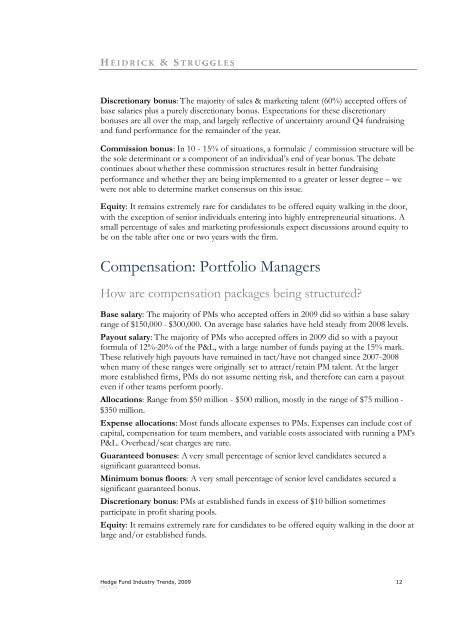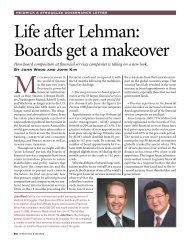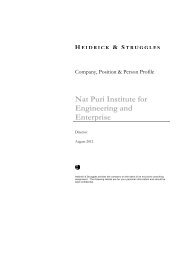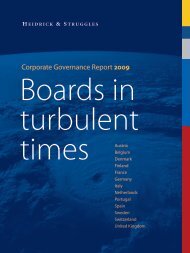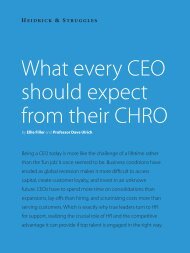Hedge Fund Industry Trends - 2009 and Beyond - Heidrick & Struggles
Hedge Fund Industry Trends - 2009 and Beyond - Heidrick & Struggles
Hedge Fund Industry Trends - 2009 and Beyond - Heidrick & Struggles
You also want an ePaper? Increase the reach of your titles
YUMPU automatically turns print PDFs into web optimized ePapers that Google loves.
Discretionary bonus: The majority of sales & marketing talent (60%) accepted offers of<br />
base salaries plus a purely discretionary bonus. Expectations for these discretionary<br />
bonuses are all over the map, <strong>and</strong> largely reflective of uncertainty around Q4 fundraising<br />
<strong>and</strong> fund performance for the remainder of the year.<br />
Commission bonus: In 10 - 15% of situations, a formulaic / commission structure will be<br />
the sole determinant or a component of an individual’s end of year bonus. The debate<br />
continues about whether these commission structures result in better fundraising<br />
performance <strong>and</strong> whether they are being implemented to a greater or lesser degree – we<br />
were not able to determine market consensus on this issue.<br />
Equity: It remains extremely rare for c<strong>and</strong>idates to be offered equity walking in the door,<br />
with the exception of senior individuals entering into highly entrepreneurial situations. A<br />
small percentage of sales <strong>and</strong> marketing professionals expect discussions around equity to<br />
be on the table after one or two years with the firm.<br />
Compensation: Portfolio Managers<br />
How are compensation packages being structured?<br />
Base salary: The majority of PMs who accepted offers in <strong>2009</strong> did so within a base salary<br />
range of $150,000 - $300,000. On average base salaries have held steady from 2008 levels.<br />
Payout salary: The majority of PMs who accepted offers in <strong>2009</strong> did so with a payout<br />
formula of 12%-20% of the P&L, with a large number of funds paying at the 15% mark.<br />
These relatively high payouts have remained in tact/have not changed since 2007-2008<br />
when many of these ranges were originally set to attract/retain PM talent. At the larger<br />
more established firms, PMs do not assume netting risk, <strong>and</strong> therefore can earn a payout<br />
even if other teams perform poorly.<br />
Allocations: Range from $50 million - $500 million, mostly in the range of $75 million -<br />
$350 million.<br />
Expense allocations: Most funds allocate expenses to PMs. Expenses can include cost of<br />
capital, compensation for team members, <strong>and</strong> variable costs associated with running a PM’s<br />
P&L. Overhead/seat charges are rare.<br />
Guaranteed bonuses: A very small percentage of senior level c<strong>and</strong>idates secured a<br />
significant guaranteed bonus.<br />
Minimum bonus floors: A very small percentage of senior level c<strong>and</strong>idates secured a<br />
significant guaranteed bonus.<br />
Discretionary bonus: PMs at established funds in excess of $10 billion sometimes<br />
participate in profit sharing pools.<br />
Equity: It remains extremely rare for c<strong>and</strong>idates to be offered equity walking in the door at<br />
large <strong>and</strong>/or established funds.<br />
<strong>Hedge</strong> <strong>Fund</strong> <strong>Industry</strong> <strong>Trends</strong>, <strong>2009</strong> 12<br />
0010159


